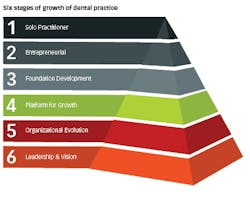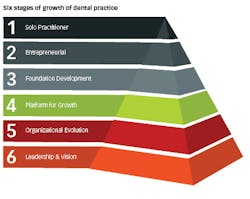Building your practice-Stage two: entrepreneurial
2–3 offices
Vincent Cardillo, MBA
In my initial article, I remarked that private-equity backed multilocation group practices, or dental service organizations (DSOs), are becoming more influential and controlling a larger portion of the dental market space. In my 20-plus years of experience growing DSOs, I’ve identified all successful and developing offices’ progress through Six Stages of Growth. Hence, as you transition from solo practitioner (Stage 1) to entrepreneurial (Stage 2) with two to three office locations, following these progressive steps will develop your foundation for further expansion.
Editor’s note: This article is part three of a seven-part series. Part four will appear in January. Find previous articles on DentalEconomics.com. Search “Cardillo.”
Last month’s article highlighted Stage 1: Solo Practitioner, and outlined five critical components essential to establishing your professional identity. This month’s article focuses on Stage 2, which is one of the most crucial of all stages of growth. Notably, this is where your business moves from you directly managing and producing in one office to you becoming a leader across two to three offices by delegating others to assume responsibilities, allowing you to mentor your clinical team and grow the practice. You’ll need to concentrate on the following critical components of Stage 2.
Human resources management
The success of your offices lies within the talent of your employees and resulting teams. Ownership of two to three offices will require hiring additional employees and the use of a payroll service, human resources (HR) organization, or internal bookkeeper to assist you with HR compliance (e.g., payroll, benefits, employee manual, OSHA training). Equally important is the designation of a regional or operations manager to oversee the day-to-day business operations as well as lead other aspects of HR (e.g., recruitment, hiring/terminations, reviews). Since you are hiring and delegating responsibility, an organizational structure (i.e., “org chart”) is an invaluable resource to not only define who reports to whom, how they report, and why they report, but also to substantiate your systems for accountability.
You may revise your org chart from Stage 1 or create one now. During this stage, one person may be responsible for fulfilling multiple jobs. Additionally, the identification of roles within your org chart may illustrate voids, necessitating the creation of additional positions.
Have lead persons from each department build clear job descriptions for roles and responsibilities. Job descriptions should establish employer expectations and explain the employee-evaluation process that is linked to specific metrics and an incentive program. Therefore, job descriptions not only become the basis for performance reviews, but they also delineate roles and responsibilities, which in turn become the foundation for your training and development.
Training and development
To maintain cohesive teams among your two to three offices, training and development must occur daily. This is operationalized by a communication protocol entailing daily morning huddles, along with weekly, monthly, and quarterly meetings to identify whether goals are being met, and bridge training and development needs for your teams.
In addition to a communication protocol, you must have manuals for all roles—including associates, hygienists, dental assistants, and front desk staff—to train, develop, and sustain your teams. The creation of these manuals can be spearheaded by the leads in each department, or obtained from an outside source and customized to your needs. These materials must be updated annually, and you must also document that your employees are trained in and adhere to their content. Importantly, these manuals serve to create consistency for both clinical and nonclinical operations across all offices. In addition to using manuals, regularly scheduled mentoring sessions with associates are essential to calibrating your clinical standard of care.
As you mentor your associates, it is imperative that you assess their diagnostic capabilities by performing monthly chart audits and consistent clinical observation. Additionally, you will need to critique their clinical abilities through observation and other mechanisms, such as evaluating the number of lab remakes occurring each month. Lastly, patient-communication skills need to be monitored through observation, team-member feedback, as well as patient-satisfaction surveys.
Regularly scheduled meetings with dental hygienists regarding periodontal philosophy and protocols, adjunctive products, scheduling, and hygiene metrics, coupled with chart audits, will correspondingly align your hygiene protocol.
Spotlight: Seeing the big picture
Do you understand your data and how to use it? Do you use your metrics to proactively make decisions? If each of your offices is running its own software, your practice data is segregated into individual silos, making it difficult to track metrics.
Inadvertently growing to three offices is essentially impossible. Your practice-management software must deliver the data you need to support your growth strategy. In Stage 2, it’s time to start thinking about centralizing and using software that can combine your disparate data.
Group practice-management software, such as Dentrix Enterprise (Henry Schein), can help you understand the larger picture of what’s happening with your business, not just individual offices, so you can make informed goals and decisions and become a more effective leader and business manager.
Spotlight sponsored by Henry Schein’s Dentrix Enterprise
Typically, when both operational and clinical calibration occurs through training and development, you will see an increase in productivity while delivering your optimal quality of care. For example, if your two associates were to increase their hourly productivity by $50 an hour, as well as your three dental hygienists increasing by $25 an hour, during a four-day work week, this would equal an annual revenue increase of $280,000.
Metrics
Metrics (also called key performance indicators [KPIs]) are the pulse of your practices and measure whether both your business and clinical objectives are being met. They therefore have a direct correlation to your HR management as well as training and development of your teams. Granted, there are a plethora of dashboards out there that can generate metrics, but you need to delineate which ones are important to you and your practice values. As a rule, understanding and utilizing metrics corresponds to employee incentive programs that reward performance. Providing employees an incentive program enables you to drive employee engagement, promote office culture, and increase earnings for all.
Financials
It is critical to have monthly financial reports such as a profit-and-loss (P&L) statement and cash-flow statements (especially important during times of growth) prepared for you by your CPA or bookkeeper. You will need to leverage his or her expertise to help you understand what the P&L means to assist you in making decisions that will have a positive impact on the sustainability of you practice. In fact, you should be receiving these reports by the 15th of each month for the prior month.
Because P&Ls are showing you a picture of the past, getting them after the 15th negatively impacts your ability to make changes immediately. It’s prudent to sit down with whoever produces your financials and your operations person in November of each year to start building a budget for the upcoming year for each office by month, and the same is true for the administrative operations (back office). This will allow you to compare on a monthly basis what actually happened to what you expected to happen in your budget. This process will be educational for you and your operations team, as you will learn how and why there was a variance between the actual P&L and what you expected in the budget.
Work-life balance
If you don’t delegate and hold people accountable, you can easily become trapped in Stage 2, hustling between offices, micromanaging, and feeling like you are running on a hamster wheel. Once you have everything organized and are delegating while holding people accountable—and also have the data that gives you the state of the practice at your fingertips—as a leader, you will worry less and have more free time. As a result, you can use spare time for things you enjoy doing, such as exercise, spending time with your family and friends, and working “on” your business instead of “in” it.
When it comes to opening a second and third location, learning how to delegate and instituting accountability are lynchpins to success. Putting HR pieces into place addresses compliance needs and increases productivity. At the same time, identifying the KPIs important to your business regulates training and development needs, while understanding financials will allow you to plan. Of course, compounding stress is damaging; therefore, achieving work-life balance will equip you for success during this critical stage. Once you accomplish Stage 2 and you decide to take further steps toward entrepreneurial growth, subsequent articles about Stage 3 and beyond will continue to guide you through this process.
Vincent Cardillo, MBA, has more than 20 years of experience owning, leading, and partnering with DSOs, the latest of which was No. 14 on the 2014 Inc. 500 List. He is the founder of Dental Management Innovations LLC. DMI positions clients for growth by strengthening their operational systems and infrastructure. Mr. Cardillo also provides his expertise to private equity firms and institutional investors. His book on the six stages of growth will be published later this year. Contact him at [email protected].


